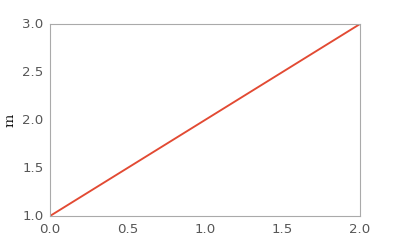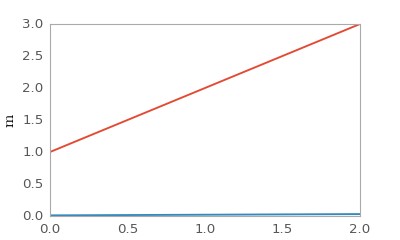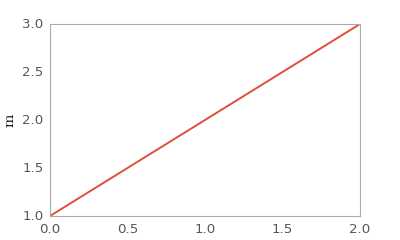Quantity¶
The Quantity object is meant to represent a value that has some unit
associated with the number.
Creating Quantity instances¶
Quantity objects are created through multiplication or division with
Unit objects. For example, to create a Quantity
to represent 15 m/s:
>>> import astropy.units as u
>>> 15 * u.m / u.s
<Quantity 15.0 m / s>
Note
Quantity objects are converted to float by default.
As another example:
>>> 1.25 / u.s
<Quantity 1.25 1 / s>
You can also create instances using the Quantity constructor directly, by
specifying a value and unit:
>>> u.Quantity(15, u.m / u.s)
<Quantity 15.0 m / s>
Quantity objects can also be created automatically from Numpy arrays
or Python sequences:
>>> [1, 2, 3] * u.m
<Quantity [ 1., 2., 3.] m>
>>> import numpy as np
>>> np.array([1, 2, 3]) * u.m
<Quantity [ 1., 2., 3.] m>
Quantity objects can also be created from sequences of Quantity
objects, as long as all of their units are equivalent, and will
automatically convert to Numpy arrays:
>>> qlst = [60 * u.s, 1 * u.min]
>>> u.Quantity(qlst, u.minute)
<Quantity [ 1., 1.] min>
Finally, the current unit and value can be accessed via the
unit and
value attributes:
>>> q = 2.5 * u.m / u.s
>>> q.unit
Unit("m / s")
>>> q.value
2.5
Converting to different units¶
Quantity objects can be converted to different units using the
to() method:
>>> q = 2.3 * u.m / u.s
>>> q.to(u.km / u.h)
<Quantity 8.28 km / h>
For convenience, the si and
cgs attributes can be used to
convert the Quantity to base S.I. or c.g.s units:
>>> q = 2.4 * u.m / u.s
>>> q.si
<Quantity 2.4 m / s>
>>> q.cgs
<Quantity 240.0 cm / s>
Plotting quantities¶
Quantity objects can be conveniently plotted using matplotlib. This
feature needs to be explicitly turned on:
>>> from astropy.visualization import quantity_support
>>> quantity_support()
<astropy.visualization.units.MplQuantityConverter ...>
Then Quantity objects can be passed to matplotlib plotting
functions. The axis labels are automatically labeled with the unit of
the quantity:
>>> from matplotlib import pyplot as plt
>>> plt.figure(figsize=(5,3))
<...>
>>> plt.plot([1, 2, 3] * u.m)
[...]
(Source code, png, hires.png, pdf)

Quantities are automatically converted to the first unit set on a
particular axis, so in the following, the y-axis remains in m even
though the second line is given in cm:
>>> plt.plot([1, 2, 3] * u.cm)
[...]
(Source code, png, hires.png, pdf)

Plotting a quantity with an incompatible unit will raise an exception:
>>> plt.plot([1, 2, 3] * u.kg)
Traceback (most recent call last):
...
UnitConversionError: 'kg' (mass) and 'm' (length) are not convertible
>>> plt.clf()
To make sure unit support is turned off afterward, you can use
quantity_support with a with statement:
>>> from astropy.visualization import quantity_support
>>> from matplotlib import pyplot as plt
>>> with quantity_support():
... plt.figure(figsize=(5,3))
... plt.plot([1, 2, 3] * u.m)
<...>
[...]
(Source code, png, hires.png, pdf)

Arithmetic¶
Addition and Subtraction¶
Addition or subtraction between Quantity objects is supported when their
units are equivalent. When the units are equal, the resulting object has the
same unit:
>>> 11 * u.s + 30 * u.s
<Quantity 41.0 s>
>>> 30 * u.s - 11 * u.s
<Quantity 19.0 s>
If the units are equivalent, but not equal (e.g. kilometer and meter), the resulting object has units of the object on the left:
>>> 1100.1 * u.m + 13.5 * u.km
<Quantity 14600.1 m>
>>> 13.5 * u.km + 1100.1 * u.m
<Quantity 14.6001 km>
>>> 1100.1 * u.m - 13.5 * u.km
<Quantity -12399.9 m>
>>> 13.5 * u.km - 1100.1 * u.m
<Quantity 12.3999 km>
Addition and subtraction are not supported between Quantity objects and basic
numeric types:
>>> 13.5 * u.km + 19.412
Traceback (most recent call last):
...
UnitsError: Can only apply 'add' function to dimensionless
quantities when other argument is not a quantity (unless the
latter is all zero/infinity/nan)
except for dimensionless quantities (see Dimensionless quantities).
Multiplication and Division¶
Multiplication and division are supported between Quantity objects with any
units, and with numeric types. For these operations between objects with
equivalent units, the resulting object has composite units:
>>> 1.1 * u.m * 140.3 * u.cm
<Quantity 154.33 cm m>
>>> 140.3 * u.cm * 1.1 * u.m
<Quantity 154.33 cm m>
>>> 1. * u.m / (20. * u.cm)
<Quantity 0.05 m / cm>
>>> 20. * u.cm / (1. * u.m)
<Quantity 20.0 cm / m>
For multiplication, you can change how to represent the resulting object by
using the to() method:
>>> (1.1 * u.m * 140.3 * u.cm).to(u.m**2)
<Quantity 1.5433000000000001 m2>
>>> (1.1 * u.m * 140.3 * u.cm).to(u.cm**2)
<Quantity 15433.000000000002 cm2>
For division, if the units are equivalent, you may want to make the resulting
object dimensionless by reducing the units. To do this, use the
decompose() method:
>>> (20. * u.cm / (1. * u.m)).decompose()
<Quantity 0.2>
This method is also useful for more complicated arithmetic:
>>> 15. * u.kg * 32. * u.cm * 15 * u.m / (11. * u.s * 1914.15 * u.ms)
<Quantity 0.3419509727792778 cm kg m / (ms s)>
>>> (15. * u.kg * 32. * u.cm * 15 * u.m / (11. * u.s * 1914.15 * u.ms)).decompose()
<Quantity 3.4195097277927777 kg m2 / s2>
Numpy functions¶
Quantity objects are actually full Numpy arrays (the Quantity
object class inherits from and extends the numpy.ndarray class), and
we have tried to ensure that most Numpy functions behave properly with
quantities:
>>> q = np.array([1., 2., 3., 4.]) * u.m / u.s
>>> np.mean(q)
<Quantity 2.5 m / s>
>>> np.std(q)
<Quantity 1.118033988749895 m / s>
including functions that only accept specific units such as angles:
>>> q = 30. * u.deg
>>> np.sin(q)
<Quantity 0.49999999999999994>
or dimensionless quantities:
>>> from astropy.constants import h, k_B
>>> nu = 3 * u.GHz
>>> T = 30 * u.K
>>> np.exp(-h * nu / (k_B * T))
<Quantity 0.995212254618668>
(see Dimensionless quantities for more details).
Dimensionless quantities¶
Dimensionless quantities have the characteristic that if they are
added or subtracted from a Python scalar or unitless ndarray,
or if they are passed to a Numpy function that takes dimensionless
quantities, the units are simplified so that the quantity is
dimensionless and scale-free. For example:
>>> 1. + 1. * u.m / u.km
<Quantity 1.001>
which is different from:
>>> 1. + (1. * u.m / u.km).value
2.0
In the latter case, the result is 2.0 because the unit of (1. * u.m /
u.km) is not scale-free by default:
>>> q = (1. * u.m / u.km)
>>> q.unit
Unit("m / km")
>>> q.unit.decompose()
Unit(dimensionless with a scale of 0.001)
However, when combining with a non-quantity object, the unit is automatically decomposed to be scale-free, giving the expected result.
This also occurs when passing dimensionless quantities to functions that take dimensionless quantities:
>>> nu = 3 * u.GHz
>>> T = 30 * u.K
>>> np.exp(- h * nu / (k_B * T))
<Quantity 0.995212254618668>
The result is independent from the units the different quantities were specified in:
>>> nu = 3.e9 * u.Hz
>>> T = 30 * u.K
>>> np.exp(- h * nu / (k_B * T))
<Quantity 0.995212254618668>
Converting to plain Python scalars¶
Converting Quantity objects does not work for non-dimensionless quantities:
>>> float(3. * u.m)
Traceback (most recent call last):
...
TypeError: Only dimensionless scalar quantities can be converted
to Python scalars
Instead, only dimensionless values can be converted to plain Python scalars:
>>> float(3. * u.m / (4. * u.m))
0.75
>>> float(3. * u.km / (4. * u.m))
750.0
>>> int(6. * u.km / (2. * u.m))
3000
Functions Accepting Quantities¶
Validation of quantity arguments to functions can lead to many repetitions
of the same checking code. A decorator is provided which verifies that certain
arguments to a function are Quantity objects and that the units
are compatible with a desired unit.
The decorator does not convert the unit to the desired unit, say arcseconds
to degrees, it merely checks that such a conversion is possible, thus verifying
that the Quantity argument can be used in calculations.
The decorator quantity_input accepts keyword arguments to
specify which arguments should be validated and what unit they are expected to
be compatible with:
>>> @u.quantity_input(myarg=u.deg)
... def myfunction(myarg):
... return myarg.unit
>>> myfunction(100*u.arcsec)
Unit("arcsec")
Under Python 3 you can use the annotations syntax to provide the units:
>>> @u.quantity_input
... def myfunction(myarg: u.arcsec):
... return myarg.unit
>>> myfunction(100*u.arcsec)
Unit("arcsec")
Known issues with conversion to numpy arrays¶
Since Quantity objects are Numpy arrays, we are not able to ensure
that only dimensionless quantities are converted to Numpy arrays:
>>> np.array([1, 2, 3] * u.m)
array([ 1., 2., 3.])
Similarly, while most numpy functions work properly, a few have known
issues, either ignoring the unit (e.g., np.dot) or
not reinitializing it properly (e.g., np.hstack). This propagates to
more complex functions such as np.linalg.norm and
scipy.integrate.odeint.
Subclassing Quantity¶
To subclass Quantity, one generally proceeds as one would when subclassing
ndarray, i.e., one typically needs to override __new__
(rather than __init__) and uses the numpy.ndarray.__array_finalize__
method to update attributes. For details, see the numpy documentation on
subclassing. For
examples, one can look at Quantity itself, where, e.g., the
astropy.units.Quantity.__array_finalize__ method is used to pass on the
unit, at Angle, where strings are parsed
as angles in the astropy.coordinates.Angle.__new__ method and at
Longitude, where the
astropy.coordinates.Longitude.__array_finalize__ method is used to pass
on the angle at which longitudes wrap.
Another method that is meant to be overridden by subclasses, one specific to
Quantity, is astropy.units.Quantity.__quantity_subclass__. This is
called to decide which type of subclass to return, based on the unit of the
quantity that is to be created. It is used, e.g., in
Angle to return a Quantity if a calculation
returns a unit other than an angular one.